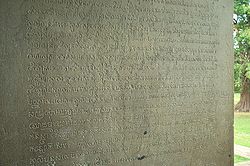Middle Khmer
| Middle Khmer | |
|---|---|

An inscription in Middle Khmer
|
|
| Region | Cambodia, parts of Thailand, Laos and Vietnam |
| Era | developed into Khmer, Northern Khmer, Western Khmer and Khmer Krom by the 18th century |
|
Austroasiatic
|
|
|
Early form
|
|
| Language codes | |
| ISO 639-3 | – |
| Glottolog | None |
Middle Khmer is the historical stage of the Khmer language as it existed between the 14th and 18th centuries, spanning the period between Old Khmer and the modern language. The beginning of the Middle Khmer period roughly coincides with the fall of the Angkorian Khmer Empire to the Siamese Ayutthaya Kingdom and the period of Cambodian history popularly referred to as the Dark ages of Cambodia. The Middle Khmer period was a stage of transition which saw relatively rapid and dramatic changes, especially in phonology, that ended with the emergence of a language recognizable as Modern Khmer approximately concurrent with the 1777 coronation of Ang Eng, the father of the poet-king Ang Duong.
Khmer has been written in an Indic-based script since the 6th–7th century. Old Khmer and the changes of Middle Khmer are recorded by an extensive epigraphy which has allowed Middle Khmer to be reconstructed and studied. During the Middle Khmer period, the language lost the voiced stops of Old Khmer which resulted in comprehensive compensatory changes to the vowel system. Old Khmer vowels following the formerly voiced stops remained mostly unchanged while the same vowels following the originally corresponding voiceless initials were lowered by different processes including diphthongization. Furthermore, the loss of final "-r", all but complete in most modern Khmer dialects, and the merger of syllable-final -/s/ to -/h/ took place during the Middle Khmer period.
Middle Khmer is attested in a wide variety of texts as well as inscriptions of the era. Middle Khmer evolved into three modern languages: Northern Khmer, Western Khmer and the various dialects of Central Khmer, including Standard Khmer and Khmer Krom.
"Old Khmer" describes the language as it existed until the 14th century. It was the language of three successive polities in the region, Funan,Chenla and the Khmer Empire (Angkor), which, at its zenith, ruled much of mainland Southeast Asia from the Mekong Delta west to the Andaman Sea and from the Gulf of Thailand north to China. Old Khmer was the language of the ruling Khmers and the language of administration throughout the empire. After the 14th century sack of Angkor by the Siamese Ayutthaya Kingdom, the Khmer Empire was terminally weakened and steadily lost both its hegemony and prestige in the region. Territory north of the Dangrek mountains was lost to Lao kingdoms while the west and northwest succumbed to the forerunners of the Thais. The Mekong Delta was lost to Vietnam. The center of Khmer culture retreated southeast and eventually was reduced to a small wedge between its powerful neighbors, Thailand and Vietnam, both of which vied for control of the rump polity as a vassal state.
...
Wikipedia
